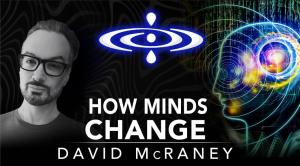
How Minds Change is a book by David McRaney in which the author, a science journalist, details what he has learned in his many years of investigation on how people make radical changes to their deeply held views on subjects. The primary example he uses is that of a so-called “Truther,” a person who believes that the attacks on the World Trade Center on September 11th of 2001 were engineered by the United States government rather than attacks from a foreign power. The man in question was a long-time leader in the Truther community, and seemed so committed to his view that he was an unlikely candidate to change his mind. However, he did change his mind, and McRaney uses his journey as an illustration on how persuasion and certainty work in human psychology.
McRaney, as a science journalist rather than a scientist, writes his book in a travelogue style. What this means is that McRaney narrates the book as a series of anecdotes about his personal experiences and the experiences of others, punctuating each section with interviews he has done with specialists or with people who have made astonishing conversions to or from a strong position which then contextualizes the points he is making.
This is an effective and engaging style of writing, but also comes with a few weaknesses. Among these weaknesses is the fact that McRaney, either knowingly or unknowingly, inserts a great deal of his personal opinion into a book which is, ironically, a study of how people change their minds on subject matters. Consequently, it isn’t as objective as the books of a psychologist like Malcolm Gladwell would be. Another weakness is that the gooey core of objective research and psychological fact is hidden in an outer layer of anecdote. Anecdotes play extremely well in engaging readers, but should not be confused with scientific rigor on their own merits.
All of this said, McRaney’s book did supply some insights relevant to research on religious conversion and deconversion.
In surveying tactics by which people’s strongly held beliefs or opinions are changed, McRaney looks at two different kinds of social engagement which have been proven effective at changing minds: Street Epistemology and Deep Canvassing.
Conversational Approaches to Changing Minds – Street Epistemology
Strangely, the book How Minds Change does a far better job of describing the methods of Street Epistemology than Bogghosian’s book A Manual for Creating Atheists which allegedly founded the movement.
It combines Freudian Psychotherapy (be a non-threatening audience to your subject), with the Socratic Method (question your subject’s assumptions), and with active listening (summarize and paraphrase your subject’s points).
However, the key to Street Epistemology is to ask your subject to gage their confidence in their claim on a scale of one to ten, then revisit their confidence level throughout the conversation to see if it slides up or down.
Street Epistemology is an effective technique for causing a person to doubt or abandon a position, though not to talk them into a new position.
SE was developed and is primarily used for deconversion of religious people, but it has expanded into an art form, and a professional Street Epistemologist makes a living by talking people out of just about anything while keeping the conversation streaming live.
SE operates in the following stages:
- establish open listening and non-threatening rapport (if the participant feels judged or attacked, they will become defensive, and the process ends)
- establish a claim (for instance, God exists, vaccines don’t work, or the earth is flat)
- ask the participant to rate their certainty for the claim on a scale of one to ten.
}THIS STEP IS CRUCIAL{
The entire purpose of SE is to undermine confidence and bestow doubt.
- if the person answers with a 10 (total certainty), you ask them the reasons for that confidence, then engage in the Socratic method until they reach the end of their ability to justify it.
- You then return to the scale and ask them to rate it again.
- if the person answers with anything less than a 10, it indicates the presence of some level of doubt. You ask what keeps them from fully committing, and then engage in “active listening” (summarizing what they have said and encouraging them to correct you or expand on their statements) until they talk themselves out of their position just by explaining their lack of total commitment.
Conversational Approaches to Changing Minds – Deep Canvassing
“Deep Canvassing” is a technique developed in California in the last ten years or so, in which individuals go door-to-door, have brief conversations with individuals about contentious political issues, and change the person’s mind with a high success rate.
The very first principle of Deep Canvassing is to make the subject feel as appreciated as possible. The canvasser makes the subject feel as if their (the canvasser’s) day is better for just meeting the subject. They are instructed to be “relentlessly positive.”
This brings to mind a technique used among small religious movements (cults) called “love bombing.” The description of love bombing is essentially the same: relentless positivity and making the person feel special and meaningful to the speaker. Both Deep Canvassers and cultic missionaries have stumbled upon the same principle: people are more liable to change their mind when they are made the center of positive attention.
Deep Canvassing (DC) is a technique similar to Street Epistemology (SE), however, unlike SE, DC looks not simply to cause people to doubt or reject their existing beliefs, but seeks to persuade the person to adopt a different position.
Used almost exclusively in the context of political concerns (gay marriage, trans issues, abortion, etc.), Deep Canvassing usually involves going door-to-door, identifying people who are on the “wrong side” of these policies, and then initiating the tactics to change their minds in a single conversation. Research suggests that it is highly effective.
The method goes according to the following guidelines:
- Establish rapport. Keep intensely positive and make the participant feel as if he or she is the highlight of your day.
- Ask people where they stand on the issue in question using a 1 to 10 scale with the extremes being entirely in favor or entirely against the issue.
- Ask people to give reasons. Show interest, ask them to elaborate, if possible get them to share stories about their personal experience.
- Once you have established that people are on the “wrong side” of the issue, ask if they have ever had any personal contact with the issue (have you ever directly known a gay/trans person? Have you ever known someone who has had an abortion or unwanted pregnancy)
- If they have had contact with the issue, ask them to tell the story, show deep interest, ask clarifying questions.
- After the person has shared his or her experience, share an experience of someone else who is directly affected by the issue at hand. Use narrative details, and make the story personal and engaging.
- Ask people their thoughts on the story shared.
- Revisit the 1-to-10 rating scale.
- If the person has moved, show interest in their reasons. If not, ask about their reasons for their position and actively listen.
- Avoid arguing with the person, or sharing your own facts or reasons outside of the narratives and stories told. The idea is to keep the conversation focused around stories and narratives – both theirs and yours – rather than reasons or arguments.
Evangelism in light of Street Epistemology and Deep Canvassing
If you are the sort of person who remembers the world pre-New Atheism, and were involved in Christianity at the time, you may recall classical Evangelism.
Evangelical churches placed a lot of pressure on members to evangelize prior to the turn of the century, and evangelism has been a standard part of Christianity for its entire history.
The classic model of Christian evangelism has relied somewhat on a salesman technique, meaning that the evangelist suggests that the participant has a problem, and that he or she (the evangelist) is offering the solution to this problem.
This is consistent with the standard model of religious conversion which suggests that the first stage is recognition of a life-stressor, and seeking the solution to that stressor.
In this respect it is different from deep canvassing and street epistemology which do not approach the individual in a Problem/Solution format.
However, one thing which is true of all three techniques is that evangelism generally is done in a method wherein the evangelist establishes rapport with the participant.
Like Deep Canvassing, however, Evangelism has classically focused on *narrative* as the method by which it changes the person’s mind. This involves probing the participant to expose some life-difficulty which they are feeling. This is followed by the evangelist sharing his or her testimony of how religion rescued him or her from a similar or more severe difficulty, and how it maintains them in a fulfilling and meaningful way.
Frequently, evangelism also introduces Biblical narratives, most especially the life and words of Jesus, as a method of conveying the message.
In this way, classic evangelism is most similar with deep canvassing.
Other Insights from the Book
In How Minds Change the author explains how brains respond to new things by the regulation of dopamine.
Say you are a student going to a theater, and discover students get in for free. Your dopamine spikes at this moment, and you associate the theater with that boost. Consequently, you are likely to choose that theater again. Now say you knew about the student policy before you went, and find out when you get there that they have discontinued the policy and now you have to pay. Your dopamine falls. You associate the theater with the downer, and are less likely to go there again.
Objectively, the theater is the same, but your expectations set you up for the dopamine boost or fall depending on how those expectations were met.
Let’s say:
Met expectations = 0.
Exceeded expectations = 1
Disappointed expectations = -1
The move from 0 to 1 or -1 causes a change in behavior.
Neurologically, conversion and deconversion work similarly: when expectations of religion collide with lived experiences, they either remain at 0 or make a leap to 1 or -1. The leap leads to a change in behavior. It is expectation+experience which leads to conversion or deconversion.
Certainty
One final insight from the book is crucial to my research, and this regards the subject of “certainty.”
As detailed elsewhere in my writings, this idea that one must be certain in order to maintain religious fidelity has played into deconversion extensively throughout my studies, with religious faith sometimes being seen as synonymous with certainty.
According to David McRaney, ‘Certainty’ is, in fact, an emotional state rather than a rational position. Reframing certainty as an emotion makes a lot more sense of religious change.
Recall from above that both Street Epistemology and Deep Canvassing have a person rate his or her certainty on a scale of 1 to 10, constantly revisiting the scale as the conversation progresses. If certainty is confused with a rational stance, as it often is, this shift up and down the scale throughout the conversation can be quite alarming to the participant. However, understood as a feeling or emotion, the presence or absence of certainty, like any other emotion, is subject to changes which are probably more physiological than rational. For instance, a person is far more likely to feel certain of his or her position when in the presence of a person who shares that position than in the presence of a skeptic.
Since so much of religious change – conversion and deconversion – relate to the person’s report on his or her certainty, the fact that certainty is a fluctuating emotional state makes the entire question of certainty more of a rhetorical stage illusion, as one confuses knowledge of a thing with certainty in that knowledge.
Think of “knowledge” or intellectual assent as something like Newtonian physics: that is to say, one remains true to a rational position until those reasons are acted upon by an outside force (alternative facts, for instance). However emotional assent works something like a wind-up car, meaning one needs consistent reinforcement to keep feeling an emotion. One needs one’s romantic partner to occasionally reaffirm his or her affection, one needs to revisit or reaffirm one’s dislike of a person or group to maintain a sense of anger or outrage, and, in the case of religion, one needs to go to church, read the Bible, and associate with other believers to re-affirm one’s feeling of certainty.
“Certainty” is an emotional state more than an intellectual one, so one cannot retain certainty of a position without dipping into the well of reinforcement for that certainty.
Conclusion
McRaney’s book is certainly worth the read and contains insights important not simply to conversion research, but to everyday life as well. If you are the sort of person who shares the political and ethical opinions of McRaney, the book should be an absolute delight. If you differ from McRaney on any matters, there may be uncomfortable moments in which McRaney applauds the successes of people changing from the “wrong” position (Truthers, for instance) to the “right” position. One may be best served to distance oneself from one’s deeply held beliefs in order to be comfortable with reading the book, should one not share the same beliefs as the author.
Recent Comments
Browse Our Archives
Related posts from Switching Sides












